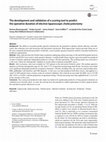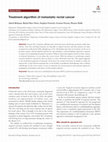Papers by Stephen Fenwick

Surgical Oncology, 2014
Gastric cancer has a high mortality, with many patients presenting with advanced disease. Many pa... more Gastric cancer has a high mortality, with many patients presenting with advanced disease. Many patients who undergo curative gastrectomy will subsequently develop metastatic disease. Hepatectomy has an established place in treating metastases from a variety of cancers but its role in gastric cancer is not clear. This review sought to systematically appraise the literature to establish the role of hepatectomy in treating gastric cancer metastases. Medline and EMBASE were searched for all papers publishing data on survival of patients with metastatic gastric adenocarcinoma who underwent hepatectomy. Seventeen studies with 438 patients were included. There were no randomised controlled trials. Perioperative mortality was 2%, with morbidity between 17 and 60%. Patients with solitary metastases appeared to have better survival. Other favourable survival characteristics included unilobar disease, and metachronous presentation. No advantage was demonstrated with either adjuvant or neoadjuvant chemotherapy. Few patients with hepatic metastases from gastric cancer are suitable for hepatectomy, but for those suitable there appears to be survival benefit. Patients with synchronous, multiple or bilobar metastases have worse survival. The evidence supporting the role of hepatectomy in the treatment of hepatic metastases from gastric cancer is weak. However in a selected group there appears to be a survival advantage; patients with solitary metastases had better survival outcomes than those with multiple metastases and metachronous presentation was associated with a better prognosis than synchronous presentation. Hepatectomy should be considered in these patients in the setting of a randomised trial.

European Journal of Cancer, 2014
Computed tomography (CT), positron emission tomography CT (PET-CT) and magnetic resonance imaging... more Computed tomography (CT), positron emission tomography CT (PET-CT) and magnetic resonance imaging (MRI) all play a role in the management of colorectal liver metastases (CRLM), but inappropriate over investigation can lead to delays in treatment and additional cost. This study aimed to determine the optimal sequence for pre-operative imaging pathway to minimise delays to treatment and healthcare costs. All patients with colorectal liver metastases referred to a single tertiary liver specialist multidisciplinary team (MDT) between 2008 and 2011 were examined. Primary data of clinical and radiological outcomes of all patients were analysed. These data were used to construct and test 3 hypothetical imaging strategies - 'Upfront', 'Sequential' and 'Hybrid' models. Six hundred and forty four consecutive patients were included. One hundred and sixty five patients were excluded for curative resection following the initial CT review. Subsequently 167/433 patients did not proceed to hepatectomies. Eighty (47.9%) of these patients had extra-hepatic disease identified on PET-CT, and 29 were due to the exclusion by MRI liver. A resectable pattern of liver disease on initial CT did not exclude patients with occult disease on PET-CT. Based on cost analysis, assessment of initial CT, followed by MDT with subsequent PET-CT and MRI imaging thereafter (Hybrid model), was associated with the shortest time-to-decision and lowest cost. Resectable pattern of liver metastases should not solely be used to determine the application of PET-CT for staging. Hybrid model is associated with the lowest cost and shortest time-to-treatment.

Surgical endoscopy, Jan 16, 2018
The ability to accurately predict operative duration has the potential to optimise theatre effici... more The ability to accurately predict operative duration has the potential to optimise theatre efficiency and utilisation, thus reducing costs and increasing staff and patient satisfaction. With laparoscopic cholecystectomy being one of the most commonly performed procedures worldwide, a tool to predict operative duration could be extremely beneficial to healthcare organisations. Data collected from the CholeS study on patients undergoing cholecystectomy in UK and Irish hospitals between 04/2014 and 05/2014 were used to study operative duration. A multivariable binary logistic regression model was produced in order to identify significant independent predictors of long (> 90 min) operations. The resulting model was converted to a risk score, which was subsequently validated on second cohort of patients using ROC curves. After exclusions, data were available for 7227 patients in the derivation (CholeS) cohort. The median operative duration was 60 min (interquartile range 45-85), with ...
European Journal of Surgical Oncology
European Journal of Surgical Oncology
European Journal of Surgical Oncology
Indian Journal of Surgical Oncology

Journal of Xiangya Medicine
Around 50% of patients suffering from colorectal cancer will develop metastasis within their life... more Around 50% of patients suffering from colorectal cancer will develop metastasis within their lifetime. Some liver and lung metastases are amenable to surgical resection, and these patients can enjoy an improved overall survival (OS), although up to 65% will develop some form of recurrence. In the era of precision surgery, with personalised medicine for each individual, a multidisciplinary approach is required to ensure we are optimising the patient's treatment. Whilst we know that surgical resection is often a matter of technical limitations, it is not always the correct choice. With the advances in oncotherapy, surgical resection should be reserved for those in whom it is clear will benefit from this. The surgical approach to the synchronous approach of metastatic rectal cancer has created controversy in whether to tackle the primary first, or deal with the metastasis first, or the benefits of neoadjuvant chemotherapy, with or without radiotherapy. In this review article, we aim to summarise the current practices and treatment options for management of metastatic rectal cancer, as well as patient selection.

European journal of surgical oncology : the journal of the European Society of Surgical Oncology and the British Association of Surgical Oncology, Jan 16, 2018
Liver transplantation in patients with unresectable early-stage (<3 cm, node negative) hilar c... more Liver transplantation in patients with unresectable early-stage (<3 cm, node negative) hilar cholangiocarcinoma has been recently reported to be associated with longer survival compared to liver resection and therefore suggested as potential treatment option also in resectable disease. Here, we investigated the outcome of resection in early-stage tumours as the standard of care in an experienced European centre. Patients with de novo resectable hilar cholangiocarcinomas who underwent liver resection between mid-2009 and December 2017 were classified as early-stage (<3 cm and node negative) or later-stage tumours (≥3 cm and/or node positive), and were investigated with respect to clinical outcome. Fifty-six patients were analyzed of whom 17 had early-stage tumours and 39 had later-stage tumours. The sex ratio (m:f) was 30:26. The median age was 65 years (range 33-80). The median follow-up was 17.0 months (range 0.7-92.4). 5-year overall survival (OS) rates were 82% in patients ...
BJR|case reports
peritoneal mature benign cystic teratoma deposits: an unusual complication from previous surgical... more peritoneal mature benign cystic teratoma deposits: an unusual complication from previous surgical resection of an ovarian mature benign cystic teratoma.

European journal of surgical oncology : the journal of the European Society of Surgical Oncology and the British Association of Surgical Oncology, Jan 11, 2018
Cholangiocarcinoma is a rare cancer arising from the biliary tree. Case series indicate that 25-4... more Cholangiocarcinoma is a rare cancer arising from the biliary tree. Case series indicate that 25-40% of all borderline resectable primary tumours are potentially resectable. The Memorial Sloane Kettering System (MSKCC) stratifies patients for resectability by longitudinal and radial extension of the hilar tumour. The Bismuth-Corlette system describes the longitudinal extension of the tumour within the biliary duct system. We sought to validate and, if possible, augment these two scores within an independent validation cohort. Patients diagnosed with hilar cholangiocarcinoma between January 2009 and December 2016 were analysed from a prospectively held database. Patients with distal cholangiocarcinoma, peripheral cholangiocarcinoma and gallbladder cancer were excluded. Comparison of surgical findings to pre-operative radiological imaging was undertaken at the time of surgery. The validation cohort was formed of 198 patients, of which, 55 (27.8%) patients underwent resection. Logistic ...
Cancer epidemiology, 2018

European journal of surgical oncology : the journal of the European Society of Surgical Oncology and the British Association of Surgical Oncology, Jul 1, 2018
Concern exists regarding the use of hepatectomy to treat colorectal liver metastasis (CRLM) in oc... more Concern exists regarding the use of hepatectomy to treat colorectal liver metastasis (CRLM) in octogenarians due to prior studies suggesting elevated morbidity and mortality. Cardiopulmonary exercise testing (CPET) within pre-operative assessment and enhanced recovery after surgery (ERAS) have both been shown to be associated with low morbidity and mortality in patients undergoing hepatectomy. This study sought to compare the outcomes of octogenarians with patients aged 70-79 undergoing hepatectomy for CRLM, within a center utilizing both CPET and ERAS. Consecutive patients age 70 or older who underwent hepatectomy for CRLM at Aintree University Hospital (Liverpool,UK), between May 2008 and May 2015 were identified from a prospectively maintained cancer database. Data were extracted and comparisons drawn. 127 patients aged 70-79 years and 34 octogenarians underwent respectively 137 and 35 hepatectomy for CRLM. There was no difference in hospital stay (6 days), morbidity and mortalit...

JMIR research protocols, Jan 9, 2018
Colorectal cancer is the fourth commonest cancer and second commonest cause of cancer-related dea... more Colorectal cancer is the fourth commonest cancer and second commonest cause of cancer-related death in the United Kingdom. Almost 15% of patients have metastases on presentation. An increasing number of surgical strategies and better neoadjuvant treatment options are responsible for more patients undergoing resection of liver metastases, with prolonged survival in a select group of patients who present with synchronous disease. It is clear that the optimal strategy for the management of these patients remains unclear, and there is certainly a complete absence of Level 1 evidence in the literature. The objective of this study is to undertake preliminary work and devise an outline trial protocol to inform the future development of clinical studies to investigate the management of patients with liver limited stage IV colorectal cancer. We have undertaken some preliminary work and begun the process of designing a randomized controlled trial and present a draft trial protocol here. This ...
European surgery : ACA : Acta chirurgica Austriaca, 2018
Surgical resection remains the only proven curative treatment for peri-hilar cholangiocarcinoma. ... more Surgical resection remains the only proven curative treatment for peri-hilar cholangiocarcinoma. Despite recent advances in liver surgery techniques and perioperative care, resection for peri-hilar cholangiocarcinoma remains associated with significant morbidity and mortality. Considerable variation in the perioperative management of these patients exists. Optimal perioperative management has the potential to deliver improved outcomes. This article seeks to summarize the evidence underpinning best practice in the perioperative care of patients undergoing resection of peri-hilar cholangiocarcinoma. The authors also seek to identify areas where research efforts and future clinical trials should be targeted.

Gut, 2018
Colorectal cancer (CRC) leads to significant morbidity/mortality worldwide. Defining critical res... more Colorectal cancer (CRC) leads to significant morbidity/mortality worldwide. Defining critical research gaps (RG), their prioritisation and resolution, could improve patient outcomes. RG analysis was conducted by a multidisciplinary panel of patients, clinicians and researchers (n=71). Eight working groups (WG) were constituted: discovery science; risk; prevention; early diagnosis and screening; pathology; curative treatment; stage IV disease; and living with and beyond CRC. A series of discussions led to development of draft papers by each WG, which were evaluated by a 20-strong patient panel. A final list of RGs and research recommendations (RR) was endorsed by all participants. Fifteen critical RGs are summarised below: RG1: Lack of realistic models that recapitulate tumour/tumour micro/macroenvironment; RG2: Insufficient evidence on precise contributions of genetic/environmental/lifestyle factors to CRC risk; RG3: Pressing need for prevention trials; RG4: Lack of integration of d...

Journal of surgical oncology, Jan 8, 2018
Scoring systems were developed to stratify patients with colorectal liver metastases considered f... more Scoring systems were developed to stratify patients with colorectal liver metastases considered for liver resection into different risk groups. Such scores have never been evaluated in recurrent liver metastases. The aim of this study was to evaluate whether these scores are applicable to patients with recurrent colorectal liver metastases and treated with curative intent. We retrospectively analyzed data from 375 consecutive patients who underwent liver surgery for colorectal liver metastases between June 2010 and August 2015. Seventy-three patients developed liver-limited recurrence treated with curative intent. The predictive value of 6 scores (Fong, Sofocleous, Nagashima, Nordlinger, Konopke, and the Basingstoke index) was assessed in this set of patients. Median follow-up was 36.2 months. Overall survival and progression-free survival were 33.6 and 5.6 months, respectively. When scores were applied for OS, none showed a significant stratification between patients, although Naga...











Uploads
Papers by Stephen Fenwick